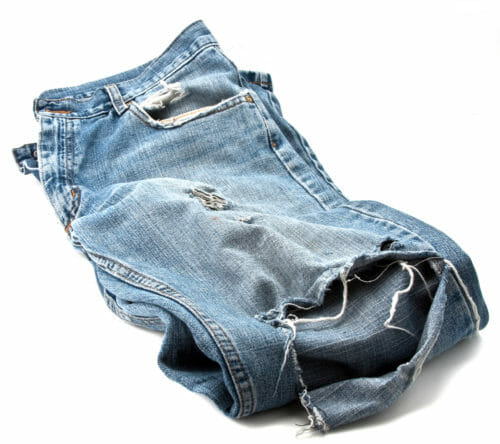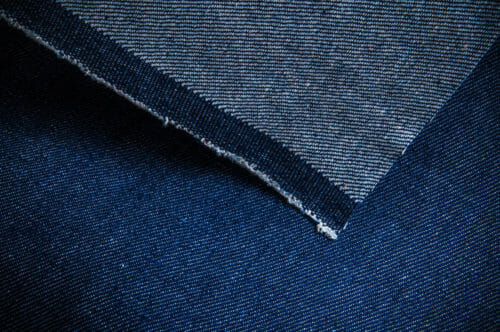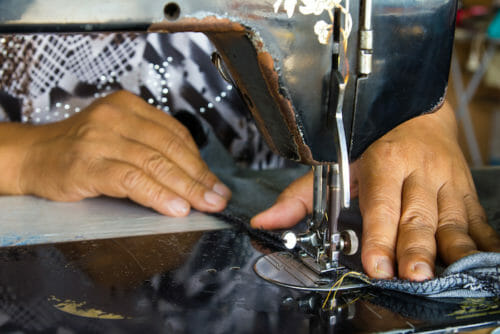
Denim is a very popular fabric these days and is synonymous with jeans. Because the fabric is so common, many sewists have limited experience with it so I wanted to offer some tips and tricks for sewing denim.
First, however, some background. Today term “jeans” usually refers to a specific style of pants, called Blue Jeans. These“rivet-reinforced” denim pants were invented by Jacob W. Davis, along with Levi Strauss & Co., in 1871. We did a post a few months about highlighting this story of Levi Strauss, who perhaps more than any other individual or institution has done more to expand the role of denim in our society.
Origins of Denim
However, given this important American contribution to the success of denim, what most people don’t know today is that denim was actually invented in France. In fact, the word “denim” comes from the French “de” which means from and “Nîmes” which is a wonderful town in the south of France where denim was invented during the Middle Ages. So denim literally means “from Nîmes”. Originally called, “serge de Nîmes”, the name eventually shortened to denim in 1864.


Nîmes is an ancient Roman city most famous for its colosseum and aqueduct known as the Pont de Gard which stands over 160 feet high over the Gardon River and was built in the first century AD as part of a 50km system to carry water to the prosperous Roman colony of Nemausus, today know as Nîmes.
The contemporary use of the word “jeans” actually comes from the French word for Genoa, Italy (Gênes) as sailors from this town were known to wear these cotton trousers. Jeans are also often referred to as dungarees which means coarse fabric and is one of the very few words from Hindi, one of the major languages from India, to make it into the English language. Cotton fabric dating back over 5,000 years has been found by archeologists in what is today West Pakistan and India.
The world's beloved “jeans” have been around for a very long time!
Characteristics of denim
Denim is a very strong, long-lasting fabric that has been extremely popular for over 100 years. Anyone who has owned a pair of jeans knows you must not skip your pre-wash. In many cases, they will shrink a little bit but also pre-washing will soften the fabric somewhat – the more you wash the softer they will become. It's always advisable to wash new denim alone, otherwise, there's a good chance some color will run off and transfer on to other clothes.


Denim is also one of the longest-lasting fabrics on the market. Jean owners know their jeans have been with them for a very long time! The irony – just when you get them exactly where you want them, they start falling apart!
If you need to tailor your denim or have a tear, you must arm yourself with high-quality thread and very sharp, strong needles. Average thread and needles will not work with this tough fabric. If you are sewing your own jeans from scrap, make sure you have the proper tools for the job:
Tools & Sewing Suggestions:
- Use sharp tools. This includes both using sharp professional-grade sewing scissors as well as sharp rotary cutters.
- Use heavy-duty needles, either ones made specifically for sewing denim like these Schmetz Denim Needles, or a universal needle that is at least size 90/14. If the denim is particularly thick, make it 100/16. These needles will have a reinforced blade to minimize needle deflection and reduce the risk of broken needles or skipped stitches.
- Use heavy-duty Jeans Thread, particularly for the topstitching associated with flat felling or if you can't find this, you might also try upholstery thread.


Denin Sewing Methods & Seams:
Again, you must have sharp tools. A very sharp pair of scissors or sharp blades in your rotary cutter will make cutting patterns much easier. Depending on the thickness of the denim, you might have to cut through the denim in layers, one layer at a time. If this is needed, make sure your flip your pattern pieces as you go along. It's also suggested that you purchase really strong pins, average pins will more than likely bend, unable to penetrate the fabric.
Denim is not the easiest material to work with, you might want to take small pieces and practice cutting; using a seam ripper and running a stitch test to determine how it looks, if the tension is correct and the best length for the stitch. You may want to use a longer stitch than normal which should be between 3 and 4.
Pay attention to your seams, there's a knack to creating seams that will save you a great deal of time. Have your iron nearby and press the seam as flat as possible. Try and cut back on bulk, as much as you can, by trimming the seam as you sew and miter any corners.
Take your time sewing, hold the fabric as firmly as you can while feeding through the machine, do not push or pull. If your sewing machine is having difficulties with a particularly bulky seam, you might want to use the handwheel. It's pretty easy to break a needle when sewing denim, so be careful.


Even though your standard presser foot should be just fine, you might want to consider purchasing a Jeans Presser Foot if one is available for your sewing machine like this one for a Bernina. It will make your sewing a great deal easier. Also, consider using a walking foot which should keep the fabric from shifting around. Depending on the year and make of your sewing machine, a jeans presser foot might or might not be available. The older your machine, the less likely you will be able to find one. Also, consider an edge stitching foot for topstitching, it will be well worth it.
Denim is one of those materials that can easily fray which is why it's important to have sharp tools. Note: If you go for a zig-zag stitch over the cut edge, on the interior seams, it will keep the material from fraying.
A beautifully flat-felled seam will give you the exact same look as those jeans you buy at the store. A flat-felled seam is also a great deal stronger, especially for stress or pressure areas. For more advice on flat-felled seams, see this article.
Your ideas
Do you have any tips or tricks to share about sewing denim? Please let us know in the comments below.








what kind of sewing machine do you recommend when it comes to sewing denim?
For best results, I would recommend this one https://amzn.to/2ZRttF3 for low budgets and this one for a higher budget https://amzn.to/2YmsWdR
To Ann that implied that a “mechanical machine doesn’t need serviced “ is absolutely incorrect… all machines need oiled & greased at some point ..& certain places … some the consumer can do but all eventually on a routine basis needs torn apart and service.. if you don’t you are asking to shorten or kill the life of your machine … without servicing you run the risk of seizing up your machine beyond repair… been seeing a lot of this since Covid 19
You should always read and follow your machines manual. My newest singer, which is computerized, specifically states “do not add oil”. Older machines yes. Always follow your manuals specifications. I have a special tiny vacuum attachment that removes dust & lint, which I use after every project. I
wash your finished item, the seams blend in and don’t look so rigid or bulky
Definitely use a denim/jeans needle for sewing on denim, not a universal needle. The denim/jeans needle has a sharp cutting tip whereas the universal has a slightly rounded tip (universal means it works on knits as well as wovens so as not to cut the knit fibers). The rounded tip means that it will push threads aside instead of piercing through them and thus the stitch will not look straight especially on the tight, dense twill weave of denim fabric (with a twill weave, the threads can be packed in tighter, which is what makes denim so strong, it’s almost like a double layer of fabric). The other advantage to a denim needle is that it is tempered for extra strength in the manufacturing process so that it is less likely to deflect & break. The other person who said to use a hump jumper is absolutely correct since leveling the presser foot when going from thin to thick layers of fabric or from thick to thin will help to prevent needle breakage and will help the feed dogs on the machine to grip the fabric and feed it. I use the white plastic tool (called height compensation plates) provided with my Bernina to level either the back or the front of the presser foot (making sure I won’t sew the plastic into my project by putting the tool under one toe of the presser foot off to the side of where the needle is sewing). The pieces of this tool have 1, 2, or 3 layers so you can customize it to whatever height you need in order to level the presser foot so it isn’t riding up or downhill and struggling to feed the fabric evenly. If one doesn’t have such a tool, you can use a piece of non-slippery fabric folded up to the right height to raise the front or back of the presser foot so it is level with what you are sewing on.
One should also increase the upper thread tension to help the take-up lever to give the upper thread a better chance to pull the lower thread into the seam so the seam is strong & balanced instead of having loops of upper thread held down below by the dense denim fabric. The more layers of denim you’re sewing, the larger the number you need to dial your upper tension to. Leave the bobbin tension alone.
The mentioned “hump jumper”, or more properly called “height compensation plates: are one of the handiest tools ever. I have had one for years. It came as a free item in some sewing supplies I ordered, it was called “Jean-a-ma-jig”. Whatever its called I have used it so many times on any number of projects, not just denim fabric or jeans. I would be lost without it!
I have so far sewn two pairs of jeans, and I have to psych myself up before each one. I use my serger a lot in the project now, and begged my old sewing machine back from my daughter so I could thread one up with regular thread and the other with top stitching thread. Since then, I have learned that the triple straight stitch on my machine with regular thread makes a nice top stitching and the color choices are greater, and I plan to try that on my next pair. stitch wiz is so right about the hammer. Find a sturdy table to do the hammering on, and I put a wooden cutting board on it for pounding seams and hammering in snaps and Jean buttons. Doesn’t every sewist have a designated sewing hammer? We should, and it should be kept clean (away from the handy man, that is).
Thank you for this great informative tutorial.
Love the article. I also love being part of a community that supports one another rather than competing with one another. Annnnd I love that the authors are so gracious about sharing readers’ tips !! In short … I love everything about this group. ????
I have a ‘hump jumper,’ but I recently just learned about using a hammer, and you can just use a bit of fabric folded over a bunch of times and use that if you don’t have one. 🙂
Using a “Hump jumper”
When you come to a thick seam there is a plastic tool you can slip around the needle (in front or behind the thick seam you are working at and you don’t loose stitches or bog down like you with out this gadget. I’ve heard people say they’ve used a fork for this too. I guess they them “Hump Jumpers”
Mira, what a great idea for using up those pants! I did not think of putting it on the bottom of those bags. I have a stack of legs left from making bags from the crotch up on the pants. I was originally going to cut them up and make lap robes, but I like the bags better. Thank you for sharing, and Mayra, thank you for all your tips and patterns! I use them for showing girls in my daughters’ service organization how to sew. Those kit bags are on my list for this summer!
Since Italian sailors were wearing jeans, (Genoa), why is this article crediting France with inventing this cotton fabric? Italians were at the forefront in creating textiles, designs, art, the radio, scientific discoveries as well as the first psychoanalyst, etc. You may be aware that the Royal Medici’s of Italy introduced the fork and knife to the royalty of France still eating with their hands? Otherwise, thank you for the tips on sewing with denim so as to create professional results;)
Denim is the fabric that came from Nime. Jeans are the garment that sailors from Genoa wore. Genes is the FRENCH word for Genoa. And dungarees is another word for garments made from tough fabric. I think the article plainly said this.
My mom taught me a different flat-felling technique in 1960. I’ve been using it for almost all my pants and jeans using medium- to heavy-weight cotton and blends. I have no way of showing it in a tutorial or pictures, but it is always very effective and easy, even when sewing seams and the front-to-back seam on pants. It lies very flat, and it eliminates 2 of the steps you have described.
Would be interested in hearing about your technic
Carol – does your technique involve offsetting the two fabric edges before sewing the first seam? And then folding the longer edge over the shorter, and then laying flat to sew down?
Would you share your method with just instructions?
Which two steps are eliminated?
Love sewing with denim. All my friends know that old jeans don’t go to goodwill but they get delivered to me. I make aprons, car trash containers, zipper pouches… It makes it so unique and gives it an extra texture. It gets hard because it’s thick and heavy but denim needles help a lot!
Pictured: zipper pouches I made my girlfriends for Passover
More denim projects…
Hi Mira, that’s fantastic! Thanks so much for sharing the things you’re working on.. Glad you enjoy working with denim. I think your comments will help the other readers alot.
Wow The pouches look so nice. Do you need a new friend??
I think this might just give me the confidence to try sewing denim for the first time. I’ve not tried it before but I think I will. I loved learning the history of the fabric. Thanks so much!
How does one fix stretched out waist elastic on denim skirts or jeans?
LuAnn
you have to replace it, open the casing and replace the elastic and close it back up. Just replecate what you see done in the waistband, the best is to video or take picture of how it looks beofre you take it apart.
Very interesting to hear about the history of denim, Mayra. I’ve featured your detailed post today.
Hi Pam, thanks for that. Kind regards.
Thanks for the excellent history lesson – I have just returned from the Provence area in France and was standing on the Pont de Gard last Tuesday (it is amazing). I wish I had known the history of denim before I went – I would have investigated further and spent some time in the actual town of Nimes.
Hi Sandy, thanks for letting me know. Sounds like a great trip!
Denim, especially new denim, can be very stiff. If you want to stitch over a flat felled seam, you have lots of bulk to deal with. A Hump Jumper will help with regular seams, but your best friend is a hammer. !!! I sew at a tailoring shop and this is our method for hemming jeans.
1. Use regular thread in the bobbin and topstitching thread on top.
2. You will need to allow 1″ for the hem. Mark the finished length, and cut 1″ below the finished length hemline. At the seam, fold the hem at just under ½” then roll it over another ½” and you will be right on your finished hemline mark.
3. Now place the rolled seam onto a firm, stable surface, grab your hammer, make sure your hem mark is visible, hit the folded seam with the hammer, firmly, about three times. (Do not do this on your sewing machine – you will damage the paint finish on your machine if it’s metal – if it’s plastic, it will break). The hammer will set the hem where you want it. Repeat with other seam(s).
4. Starting at the inseam, stitch your hem – on the outside of your garment! It’s easy to see that your sewing line is consistent.
5. Press well with lots of steam.
You will have beautiful hems that look as good as the factory hems.
Love what you are doing! Younger eyes and minds will find other ways of doing things. I’ve been sewing for well over 50 years and I’m still learning – Happy Stitching!
Stitchwiz, your method of hemming jeans is exactly what I have used for many years. I agree that it works perfectly! I also use a longer stitch…3 or 3.5.
And what type of machine are you doing these professional hems with?!
Professional tailors have a “heavy” industrial plain sewer for tightly woven thick & heavy fabrics. You can sew denim & other stiff fabrics on occasion, but this will cause severe wear & tear on your domestic machine, especially today’s flimsily-made, light-weight sewing machines. These machines will fall apart on you, guaranteed if you regularly put them under strain with denim et al fabrics. About machines, I had a Janome QC 4900 domestic sewing machine & only sewed for myself with mostly light weight fabrics. It did not last the distance. Within 1 year of light use, things were going wrong & falling off. This was a mid range, not cheap machine & it lasted me just a few short years before it totally packed up on me. I had it serviced every year, at $250.00 each time. What an expensive blowout these computerised machines are. I now have a beautiful mechanical Elna Explore 340. No problems whatsoever. No more computerised sewing machines for me anymore. With mechanical models, they just need cleaning, & mine no oiling. Servicing is not required as for computerised models. Add up just what this computerised machine cost me over 8 years.
Sorry to tell you but all machines need servicing … grease and oil don’t last forever in any machine especially when you add fibers to help absorb these products … since the civil 19 we have been seeing a lot of mechanical machines “ seize up” because of lack of service.. now most are junk ,,, from non servicing….
This are fantastic Tips! Thank you!
Great tips! You obviously know your stuff! Thanks for sharing and for admitting that you’re still learning even after all these years!
I love this article! I have several pairs of jeans that I want to make some things with.
Thank you for all your wonderful tips, patterns snd articles. Very informative!
Ah this brought back memories. I thought I recognised that bridge. I love that area and have walked across the Pont du Gard – it’s amazing, to think its still been standing there, delivering water since Roman times. But I had no idea that denim came from that area. Thanks for such an interesting article Mayra.